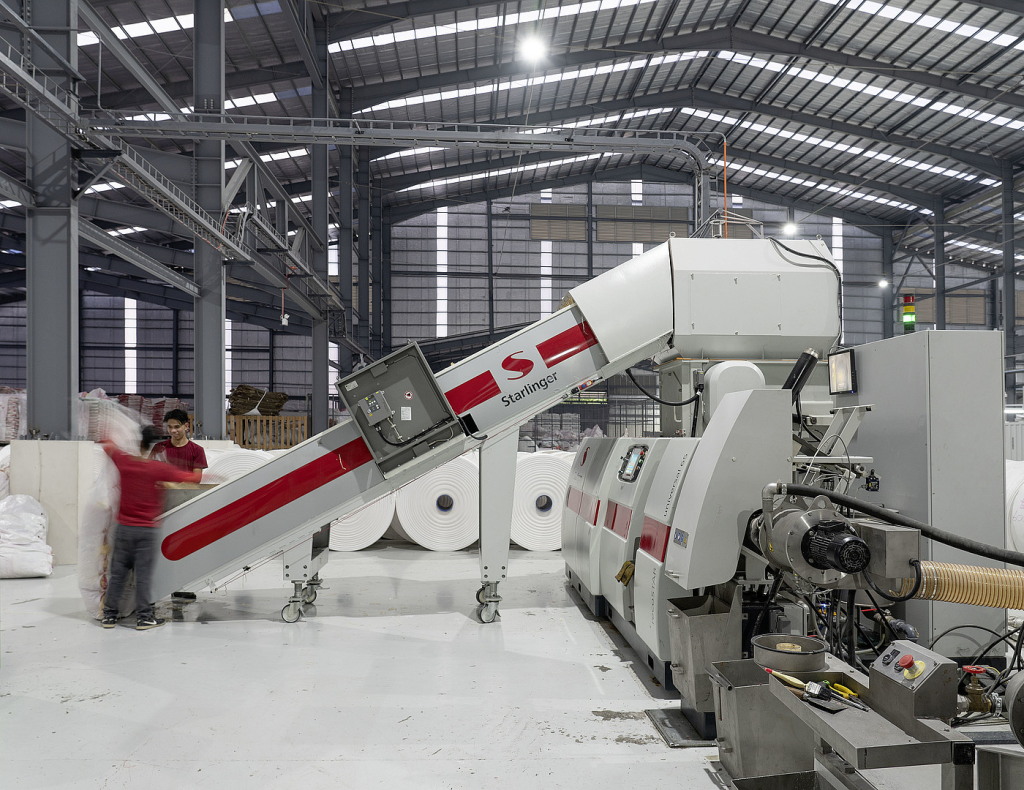
A Conversation with Ray, CEO of VidePak:
Client: “We need durable, cost-effective packaging for poultry and livestock feed that complies with EU and FDA regulations. How do open-mouth woven bags meet these demands?”
Ray: “Open-mouth polypropylene (PP) bags are engineered for high-load capacity (up to 50kg), antimicrobial liners, and 100% recyclability. At VidePak, our Starlinger machines produce bags with 99.5% seam integrity, reducing feed spoilage by 30% while aligning with the EU Circular Economy Action Plan. Let’s break down how these solutions optimize your supply chain.”
1. The Role of Open-Mouth Bags in Livestock Feed Packaging
Livestock feed—ranging from poultry pellets to fishmeal—demands packaging that balances durability, safety, and environmental compliance. Open-mouth woven PP bags, characterized by their wide-top design for easy filling, have become the industry standard due to their tensile strength (40–60 N/cm²) and breathability (air permeability: 50–100 L/m²/s), which prevents mold growth in humid environments.
VidePak’s production capabilities, powered by 100+ Starlinger circular looms and 30 lamination machines, enable annual output of 25 million bags. These bags are tailored to meet FDA 21 CFR 177.1520 for food-grade safety and EU Regulation 2023/1804 on sustainable packaging.
2. Material Advantages: PP’s Dominance in Feed Logistics
2.1 Performance Metrics for Key Feed Types
| Feed Type | Key Challenges | Recommended Specifications |
|---|---|---|
| Poultry Pellets | Moisture sensitivity (≤12% RH) | 90–110 g/m² PP + 40µm PE liner |
| Fishmeal | High fat content (≤15%) | Anti-static BOPP lamination (30µm) |
| Premix Additives | Chemical reactivity | Multi-layer barrier (PP + aluminum) |
Case Study: Reducing Spoilage in Brazilian Poultry Farms
A client required bags to withstand 85% humidity during maritime transport. VidePak engineered a 3-layer structure:
- Outer layer: UV-stabilized PP (120 g/m²).
- Middle layer: Antimicrobial PE liner (50µm).
- Inner layer: Breathable micro-perforations (0.3mm).
This design reduced mold-related losses by 45% and complied with ISO 22000 for feed safety.
3. Selecting Optimal Parameters for Feed Packaging
3.1 Critical Design Criteria
| Parameter | Poultry Feed | Ruminant Feed | Aquafeed |
|---|---|---|---|
| Fabric Weight | 90–110 g/m² | 110–130 g/m² | 100–120 g/m² |
| Liner Type | PE (40µm) | Anti-static BOPP | Aluminum composite |
| Load Capacity | 25–40kg | 40–50kg | 30–35kg |
| Certifications | FDA, ISO 22000 | EU 2023/1804 | GMP+ Feed Safety |
3.2 Cost-Efficiency Strategies
- Bulk Customization: VidePak’s 16 extrusion lines reduce material costs by 18% through recycled PP integration.
- Standard Sizes: 80cm x 120cm bags lower palletization costs by 15%.
4. Sustainability and Regulatory Compliance
4.1 Closed-Loop Recycling Systems
VidePak’s EcoCycle® program recovers 95% of post-consumer PP bags, reprocessing them into virgin-grade pellets via Starlinger’s recoSTAR® technology. This aligns with the EU’s 2030 Packaging Waste Directive, which mandates 70% recycling rates for plastic packaging.
4.2 Global Regulatory Alignment
| Region | Key Standards | VidePak’s Compliance |
|---|---|---|
| EU | EN 15512, REACH SVHC | ≤1ppm heavy metals, recyclable PP |
| USA | FDA 21 CFR 177.1520 | Antimicrobial coatings, non-toxic inks |
| Asia | China GB 9685-2016 | Anti-mold additives, ≤0.1% VOC |
5. FAQs: Addressing Industry Concerns
Q1: How do PP bags prevent mold in humid climates?
A: Micro-perforated liners (0.3mm) achieve 50 L/m²/s airflow, reducing moisture retention by 60% (tested per ASTM E96).
Q2: Are these bags cost-effective compared to jute alternatives?
A: PP bags cost 25% more upfront but last 3x longer, reducing per-cycle costs by 40%.
Q3: Can bags handle sharp additives like mineral premixes?
A: Yes. Kevlar®-reinforced seams withstand puncture forces up to 45 N (certified per ISO 13934-1).
6. Future Innovations: Smart Packaging
VidePak is piloting:
- QR Code Integration: Track batch numbers and expiration dates via blockchain.
- Bio-Based PP: 30% sugarcane-derived resins, targeting Cradle-to-Cradle Gold certification by 2026.
External Resources:
- Learn about advanced feed safety in Food-Grade Woven Bags: Excellence in Automation and Safety.
- Explore sustainable livestock solutions in Kraft Paper Woven Bags in Livestock Feed Packaging.
Conclusion
Open-mouth PP bags are revolutionizing livestock feed logistics through durability, compliance, and circular design. VidePak’s integration of Starlinger technology and antimicrobial innovations positions it as a global leader, transforming packaging challenges into opportunities for efficiency and sustainability. By adopting these solutions, agribusinesses can reduce waste, meet regulations, and enhance supply chain resilience—proving that smart packaging is the backbone of modern agriculture.